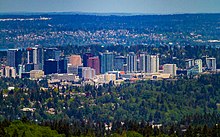Portal:Cities
The Cities Portal

A city is a human settlement of a notable size. The term "city" has different meanings around the world and in some places the settlement can be very small. Even where the term is limited to larger settlements, there is no universally agreed definition of the lower boundary for their size. In a more narrow sense, a city can be defined as a permanent and densely settled place with administratively defined boundaries whose members work primarily on non-agricultural tasks. Cities generally have extensive systems for housing, transportation, sanitation, utilities, land use, production of goods, and communication. Their density facilitates interaction between people, government organizations, and businesses, sometimes benefiting different parties in the process, such as improving the efficiency of goods and service distribution.
Historically, city dwellers have been a small proportion of humanity overall, but following two centuries of unprecedented and rapid urbanization, more than half of the world population now lives in cities, which has had profound consequences for global sustainability. Present-day cities usually form the core of larger metropolitan areas and urban areas—creating numerous commuters traveling toward city centres for employment, entertainment, and education. However, in a world of intensifying globalization, all cities are to varying degrees also connected globally beyond these regions. This increased influence means that cities also have significant influences on global issues, such as sustainable development, climate change, and global health. Because of these major influences on global issues, the international community has prioritized investment in sustainable cities through Sustainable Development Goal 11. Due to the efficiency of transportation and the smaller land consumption, dense cities hold the potential to have a smaller ecological footprint per inhabitant than more sparsely populated areas. Therefore, compact cities are often referred to as a crucial element in fighting climate change. However, this concentration can also have significant negative consequences, such as forming urban heat islands, concentrating pollution, and stressing water supplies and other resources. (Full article...)
Selected city -
Xi'an is the capital of Shaanxi Province. A sub-provincial city on the Guanzhong Plain, the city is the third most populous city in Western China, after Chongqing and Chengdu, as well as the most populous city in Northwest China. Its total population was 12,952,907 as of the 2020 census. The total urban population was 9.28 million.
Known as Chang'an (Chʻang-an) in much of its history, Xi'an is one of the Chinese Four Great Ancient Capitals, having held the position under several of the most important dynasties in Chinese history, including Western Zhou, Western Han, Sui, Northern Zhou and Tang. Xi'an is now the second most popular tourist destination in China. The city is the starting point of the Silk Road and home to the Terracotta Army of Emperor Qin Shi Huang, both of which are listed as UNESCO World Heritage sites. (Full article...)Did you know -
- ... that early in her career, Maria Calegari danced principal roles in every ballet performed one weekend by the New York City Ballet?
- ... that until the opening of Altay railway station in June 2017, no railway services were provided to Altay City, a tourist attraction with rich mineral resources?
- ... that a 19th-century horse stable in New York City later housed a luxury pet sitter for cats and dogs?
- ... that Hurricane Henri, a minimal category 1 hurricane, set a rainfall record in New York City's Central Park?
- ... that in 1987, an estimated one-sixth of New York City's homeless children lived at the Martinique Hotel, even though it lacked basic facilities like kitchens?
- ... that the bamboo-filled atrium of the IBM Building was described as "New York City's peerless privately owned public space"?
Related portals
Related WikiProjects
Ashdod (Hebrew: אַשְׁדּוֹד, romanized: ʾašdōḏ, pronounced [ʔaʃˈdod] ⓘ; Arabic: أسدود, romanized: ʾasdūd, pronounced [ʔasˈduːd], or إسدود, ʾisdūd [ʔɪsˈduːd]; Philistine: 𐤀𐤔𐤃𐤃, romanized: *ʾašdūd) is the sixth-largest city in Israel. Located in the country's Southern District, it lies on the Mediterranean coast 32 kilometres (20 miles) south of Tel Aviv and 20 km (12 mi) north of Ashkelon.
The city was named after the historical town of Ashdod, located c.6 km southeast, which dates originally to the 17th century BCE as one of the five Philistine city-states. The ruins of Ashdod-Yam also lie on the coast to the southwest of the city center and adjacent to the city's expanding suburbs. (Full article...)Selected article -

General images -
Topics
List articles
Subcategories
Associated Wikimedia
The following Wikimedia Foundation sister projects provide more on this subject:
-
Commons
Free media repository -
Wikibooks
Free textbooks and manuals -
Wikidata
Free knowledge base -
Wikinews
Free-content news -
Wikiquote
Collection of quotations -
Wikisource
Free-content library -
Wikiversity
Free learning tools -
Wiktionary
Dictionary and thesaurus









































